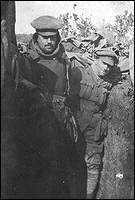|


|

|

Gallipoli
One year of the war elapsed before the Newfoundlanders were sent to an active front.
The regiment’s first encounter with the realities of war on the Gallipoli Peninsula was mild in
relation to subsequent events on the Western Front. Nevertheless, it was at
Gallipoli that the regiment received its baptism of fire, during which it acquired a reputation
for steadfastness and courage.
On August 19, 1915, the Newfoundland Regiment received word that it was to be sent
to Gallipoli and assigned to the 88th Brigade as part of the 29th Division
of the British Army. After a brief stopover in Egypt, the 1,076 Newfoundlanders
landed on the shores of the Dardanelles on September 19, 1915.
Cape Helles, Gallipoli.
Photo taken between December 22, 1915 and January 9, 1916.
Courtesy of the Provincial Archives of Newfoundland and Labrador (PANL B3-15), St. John’s,
Newfoundland.
 (44 Kb)
(44 Kb)
|
 |

|
The soldiers arrived expecting action and excitement. They were soon disappointed;
they spent the first few months digging trenches and keeping long night watches. In
November 1915, Lieutenant Owen Steele commented on the lack of action, adding
“However, we may get some excitement yet” (Steele, “Extract from letter November 1,
1915”).
Steele’s predictions were soon fulfilled. Before leaving the peninsula in January 1916,
the regiment suffered its first casualties, survived a vicious November storm, twice aided in the
successful withdrawal of troops from the peninsula and won its first battle honours after the
capture of Caribou Hill in November.

|
 |
B Company in front line, Suvla Bay, 1915.
Capt. Alexander (left) and Capt. Nunns (right).
Courtesy of the Provincial Archives of Newfoundland and Labrador (PANL VA-37-1), St. John’s,
Newfoundland.
 (19 Kb)
(19 Kb)
|
It was also at Gallipoli that the regiment came under the command of the man who is
said to have “made the Regiment,” Lieutenant-Colonel A. L. Hadow, a regular British Army
officer. Although Hadow was not popular with his troops, he earned their respect. It was
under his stern command that the Newfoundlanders went into battle at Beaumont Hamel on
July 1, 1916.

|

|
 |